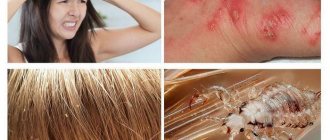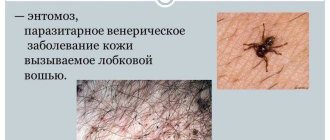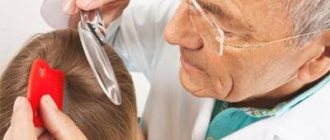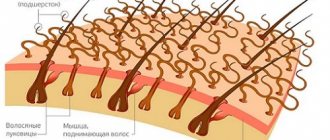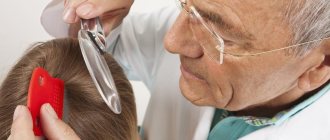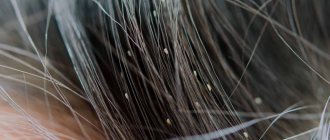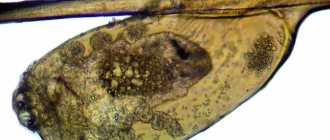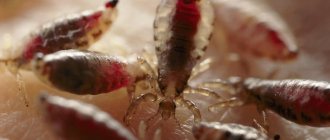Lice drink blood, so it makes no difference to them what kind of hair they get, dyed hair or natural hair. They need hair only to hide in it and secure their larvae. Many girls think that parasites cannot live on dyed curls, but the composition of modern dye does not harm the skin, hair and parasites. In this article, you will find out whether lice can grow on dyed hair and whether they can be removed by re-dyeing.
3Can lice live on colored hair?
If you become infected with parasites after dyeing your hair, this will not prevent them from living and reproducing on your head. When the dye is used after infection, the effect is different. In this case, you can completely get rid of pests.
However, before this procedure, it is better to weigh the pros and cons, because lice can be removed with much less sacrifice for colored hair - for example, with a special shampoo. Besides, don’t expect a miracle after the first painting. Most likely you will need to repeat the paint treatment 2-3 times. This event will greatly harm colored curls. The parasites, of course, will disappear, but the condition of the hair will noticeably worsen.
What are the contraindications?
If there are contraindications, treatment with paint is strictly prohibited. Otherwise, other problems will be added to pediculosis.
Dye therapy is not suitable for you if:
- the presence of wounds and pustules on the surface of the skin;
- the presence of a large number of bites that have turned into ulcers;
- pediculosis in advanced form;
Doctors do not recommend pregnant women to dye their hair
- severely weakened hairline;
- pregnancy;
- under 18 years of age.
Despite many opinions, the procedure is strictly prohibited for children. For minors, coloring is dangerous, especially frequent.
4How to remove lice using paint
- First, apply the dye to your hair.
- Then wrap the dyed hair in a plastic bag.
- After forty minutes, remove the dye from your head using warm water.
- At the end of the procedure, you should comb the dyed hair with a special comb with rare teeth.
Note that coloring only relieves a person of adult lice. Nits do not suffer from the effects of chemical composition. But special shampoos will help cure head lice completely, killing eggs and adults. If the first painting does not help, repeat it after ten days.
Alternative Treatments
All methods of getting rid of lice can be divided into three main groups:
- • Mechanical removal. This method involves removing live parasites and nits manually. To do this, take a fine-toothed comb and comb your hair thoroughly. The advantage of this method is that it is absolutely safe. Disadvantage: you will have to spend a lot of time and effort to completely get rid of lice.
- • Home remedies. There are a huge number of lice recipes that can be used at home. These include: essential oils, kerosene, mayonnaise, olive oil, vinegar and many others. The main disadvantage of these methods is low efficiency. In most cases, treatment is delayed and ultimately the insects have to be removed mechanically. The advantages include financial savings - most ingredients can be found in every kitchen
- • Pharmacy drugs. Today you can find a wide range of pediculicides in pharmacies. These can be shampoos, emulsions and sprays. The undoubted advantage of using pharmaceutical products is that they are all pre-tested and are considered relatively safe. The downside is that lice have become resistant to insecticides, so many drugs are simply ineffective.
5Nit paint
In fact, there is no special paint for nits. As we noted earlier, the chemical composition allows you to kill only adult parasites on colored strands. New lice will hatch from the eggs in a couple of days.
What is in the composition of hair dye that has a detrimental effect on pests? The whole secret is hydrogen peroxide (ammonia). This component penetrates the insect's respiratory tract and leads to its suffocation. But even peroxide cannot cope with the thick shell of nits. This is why trichologists insist on using shampoos for head lice. They are more effective in the fight against nits.
Be careful: the dye causes the egg to detach from the hair. On the one hand, this is good, because after the procedure you can comb out the parasites. On the other hand, nits that have fallen off imperceptibly continue to live. If they are not noticed in time, after hatching the parasites will find a new refuge. There is a high probability that after the initial healing there will be a need to treat the colored strands.
That's why using anti-lice hair dye requires following several rules. Firstly, you cannot walk around the apartment during the procedure. Secondly, you should comb dyed curls with a comb over white paper in order to notice parasites in time. Third, check the head for eggs.
What safety methods should be used with this method of getting rid of lice?
Despite the fact that many of us consider the dyeing process a routine procedure, we should not forget about the safety rules:
- 1. Before the procedure, check the paint for an allergic reaction. To do this, apply a small amount of paint to the skin of your hand (elbow area or wrist) and leave for 12 hours. If during this time no signs of allergy appear - itching, swelling, redness - the paint can be used.
- 2. Carefully examine your scalp before the procedure. Do not use hair dye if there are wounds on the scalp that appeared after combing lice bites. When chemicals get into these wounds, they can cause burns or allergies.
- 3. Use disposable gloves to protect your hands
- 4. Be careful not to get the coloring agent in your eyes or mouth.
- 5. Avoid inhaling paint fumes. Carry out the procedure in a well-ventilated area.
As mentioned above, ammonia paints should not be used to treat lice in children.
Life cycle of insects
When a head louse lands on a person's head, it immediately lays eggs. Attach them at a distance of 1 cm from the hair roots. The location of the nits relative to the hair roots determines the age of infection. Appearance: like flakes of dandruff.
Lice and nits are human parasites. For their successful life, certain conditions are required, as well as the structure of the hair. Animal fur does not allow insects to attach eggs, so infection does not occur.
Where do lice live except on the head - where there is hair that is similar in structure to the hairs of the head. With severe infection, pediculosis spreads to the eyebrows, armpits, and abdomen. Another species parasitizes pubic hair and eyelashes - pubic lice.
Lice on the head
Every day, one louse on the head lays about 10 eggs. Egg laying occurs every 4 hours. Nits develop in the egg for about a week. They are born in the smallest individuals, the body length of which does not exceed 2 mm. They look like adult lice, but are lighter in color.
The process of removing parasites
Regardless of which lice and nit removal product will be used, the entire process of exterminating parasites should look like this:
- Wash your hair.
- Apply the product for the treatment of head lice according to the instructions or recommendations.
- Comb out adult parasites and nits.
- Repeat the procedure to consolidate the result after 7-10 days or according to the instructions.
You need to understand that the key to success lies in the complex use of “poisonous” substances and mechanical cleaning of the hair.
Some medications or, for example, cranberry juice can slightly lighten the tone of colored hair. But this will not affect his health in any way.
IMPORTANT! Repeated dyeing can only be done on healthy hair. Otherwise, lice may not only break out with renewed vigor, but the hair itself will look very untidy and disgusting.
Transmission routes
Parasites can also be transmitted through personal hygiene items, combs, hairpins, hair ties and hats.
It is possible, but less common, to become infected with head lice through bedding and pillows. More often, infection occurs when sleeping together. It is very rare, but it is not impossible to become infected with lice while swimming in stagnant water if people with lice are swimming nearby.
Most often, infection with pediculosis occurs in the summer, in places with large crowds of people - in children's camps, kindergartens, etc.
No one is immune from head lice infection. Of course, systematic hygiene procedures are the main methods of prevention, but they do not exclude the possibility of infection.
And the process of reproduction of lice from the moment they land on the head is carried out continuously, individuals increase exponentially. If you do not take any measures to eliminate parasites, they will live on the scalp indefinitely.
Now you know how long a lice lives on the head, whether lice live outside the head and whether they can live on animals.
Parasites can appear even in clean people who live in good conditions. They are caused by close contact with an infected person. Parasites pass from the “host” during games, sexual intercourse, wrestling, and accidental touching of the head.
Where do head lice in children come from? In children's groups, the spread of these insects occurs at lightning speed. They can be transmitted to healthy babies through shared towels or pillows, when bathing in the bathtub or wearing other people's hats. Therefore, a high risk of infection is observed in gardens and schools, swimming pools, hotels, and trains.
Life outside of man
Lice survive only at the expense of their host, on whom they parasitize. Can lice live outside humans and for how long? Each type of insect can only live on a specific mammal.
The opinion that lice are transmitted from pets is completely erroneous.
Blood-sucking insects feed frequently and in small portions, and females bite more often than males, but how long can lice live without humans?
A head louse deprived of food in the environment can exist without a person for about 2 days, or more precisely, about 55 hours - that’s the entire length of time that lice live without a person.
https://www.youtube.com/watch?v=O2MQtcvx9j8
How long lice live without food is a controversial issue. According to various sources, from 1 to 3 days. At room temperature, the insect can live for three days; once outside, it dies almost instantly in frost, within several hours at temperatures below 10 degrees Celsius.
Louse without food
How long a nit lives is much easier to answer. The durable shell protects the larva from the negative effects of surrounding factors and does not even penetrate toxic substances. But for the full development of lice, special conditions and a certain temperature regime are necessary. At high and low temperatures, parasites die.
The body temperature is about 37 degrees Celsius. If a nit with a torn hair falls to the floor, its development will stop
It is not so important how long she lives, the main thing is that she will not be born alive
Types of lice
The insect is divided into three types, depending on the place of life:
- Cootie. She is attracted by the human smell and is unable to live on a body. The parasite lives in folds of clothing and bedding.
- Pubic louse. Can live where coarse hair grows - eyelashes, mustache, pubis, armpits.
- Head lice and nits. They live only on the human head.
Those who are faced with a disease such as lice begin to wonder how long lice live without food. Each species differs from each other in this regard:
- The head dies after 2 days without human blood. The nit will go through its life cycle completely, but the hatched larva, without finding food, can live only for an hour.
- The pubic look won't last more than four hours. The egg will develop until it is the turn of the nymph to hatch, which will immediately die.
The human body is not suitable for permanent residence. Then the question arises: can lice live in pillows and blankets? This type of insect is able to take a liking to bedding, but only if it has access to a food source. No matter what type of lice they are, they do not live without humans.
People are concerned about approximately the same questions regarding the life of these insects. Here are the most common:
- How long do lice live on a person’s head? They usually die a month after their appearance. If a living parasite finds itself without a person at room temperature, it must find another victim within 24 hours. If the temperature is low, the pest goes into hibernation.
- Do lice live in bed linen? This can happen to an unscrupulous person. The clothing species prefers to live in the folds of clothing adjacent to the body, but the insect can move onto the bed and bedding. It’s not for nothing that the parasite is popularly called a linen louse. If you change the bedding, it won't stay there.
- Can lice live on a sofa - the answer to this question will not differ from the previous one. Furniture is not the place where an insect will build a “home.” It needs a constant power source.
If at least one lice is noticed on the head, the hair should be carefully checked and treated. The parasite is small in size and difficult to detect. Having found a mate, one individual will quickly breed.
Although insects are not characterized by a long life cycle, they cause a lot of problems for humans. Because of them, you have to limit yourself in communication and endure many inconveniences. Fortunately, getting rid of lice is quite simple. To do this, use pharmaceutical pediculicidal preparations or folk remedies.
Is henna effective for fighting head lice?
Henna itself does not destroy parasites. The composition contains components that dissolve the substance used by pests to attach nits.
For treatment, henna is applied to the hair. To do this, the substance is placed in a glass container and filled with hot water. The resulting mass should be mixed thoroughly. The consistency should resemble thick sour cream.
Apply henna to the entire length of your hair. After 30 minutes, rinse off the substance. Comb the strands with a comb. Removed parasites are destroyed.
This video will tell you about different methods of eliminating lice:
Symptoms of neurocysticercosis
Symptoms of parasites in the brain appear gradually. With a small size of the parasite, the manifestation of the disease is characterized by internal irritations, the patient’s sensitivity decreases and speech is impaired.
With the development of cerebral cysticercosis, attacks of epilepsy appear, which pass with convulsions. The patient suffers from mental disorders, hallucinations, and depression. With the onset of edema, the patient experiences dizziness, nausea and vomiting.
Symptoms of the presence of parasites in the human brain depend on the location of the source of the disease. If neurocysticercosis is located in the cerebral ventricles, the patient develops Bruns syndrome, in which the lumens of the 4th ventricle may be blocked by parasitic formations. With such localization in a patient:
- Changed head position
- Severe headaches
- Respiratory dysfunction
- Nausea and vomiting
- Increased sweating
- Consciousness is confused
- The functioning of the heart is impaired.
When the foramen of Monroe closes, the symptoms are similar to those of a tumor and are accompanied by disturbances of consciousness. As a result of infection of the base of the brain, basalt-type meningitis develops. With such an infection, the following manifestations are possible:
- Vomit
- Headache
- Optic nerve damage
- Bradycardia
- Changes in blood composition.
If a diagnosis is made in a timely manner and effective measures are taken, the probability of a favorable treatment outcome is 50%.
